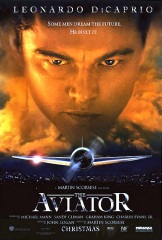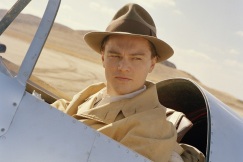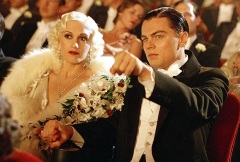|
The Aviator |
| |
 |
USA/Japan, 2004. Rated PG-13. 169 minutes.
Cast: Leonardo DiCaprio, Cate Blanchett, Kate Beckinsale, Alec Baldwin, John C. Reilly, Alan Alda, Ian Holm, Matt Ross, Adam Scott, Danny Huston, Kelli Garner. Cameos by Jude Law, Willem Dafoe, Gwen Stefani, Brent Spiner, Rufus Wainwright, Martha Wainwright, Loudon Wainwright
Writer: John Logan
Original Music: Howard Shore
Cinematography: Robert Richardson
Producers: Michael Mann, Sandy Climan, Graham King, Charles Evans Jr, Leonardo DiCaprio
Director: Martin Scorsese
LINKS
|
Note: If you don't know anything about billionaire Howard Hughes, you may prefer to see the film before reading this review. If you're relatively familiar with his life, this review shouldn't contain any significant spoilers.
 hen you think Martin Scorsese, you think of Travis Bickle waving a gun in front of a mirror, demanding, “You talking to me?” You think of Jake La Motta practicing his sad standup routine in front of a bathroom mirror in the final scene of Raging Bull. When you think of Scorsese, you don't think of climactic confrontations between a hero and his bad-ass nemesis (even though Scorsese has done them). The reason mirrors figure prominently in Scorsese's greatest scenes is because the protagonist's nemesis is usually himself. Think of Raging Bull, Goodfellas, Taxi Driver, and The Last Temptation of Christ. These films are about conflicted men unable to accept their allotted place in society. Men who yearn for something more. Men whose flaw is often the source of both their greatness and their destruction. Aristotle called this the Tragic Flaw.
hen you think Martin Scorsese, you think of Travis Bickle waving a gun in front of a mirror, demanding, “You talking to me?” You think of Jake La Motta practicing his sad standup routine in front of a bathroom mirror in the final scene of Raging Bull. When you think of Scorsese, you don't think of climactic confrontations between a hero and his bad-ass nemesis (even though Scorsese has done them). The reason mirrors figure prominently in Scorsese's greatest scenes is because the protagonist's nemesis is usually himself. Think of Raging Bull, Goodfellas, Taxi Driver, and The Last Temptation of Christ. These films are about conflicted men unable to accept their allotted place in society. Men who yearn for something more. Men whose flaw is often the source of both their greatness and their destruction. Aristotle called this the Tragic Flaw.
Scorsese's brilliance has lain in his unique creativity to externalize the conflict for the benefit of viewers, then to gradually break down the character until his inevitable meltdown. As Scorsese's films have grown more ambitious, lush, and sweeping, however, they have also grown less centered and focused. With Gangs of New York, Scorsese had moved so far away from what he does best that it was, in a way, the antithesis of a Scorsese film—a movie whose protagonist is so completely overshadowed by an external antagonist that his internal demons no longer drove the story or commanded any audience interest.

Leonardo DiCaprio stars as Howard Hughes in The Aviator. |
Good news. Mirrors make a triumphant return in The Aviator, in the first scene and the last scene, and several in between. With The Aviator, Scorsese has once again made a film about man versus himself.
That man is Howard Hughes (Leonardo DiCaprio), known to most people as an eccentric billionaire who lived out his life in paranoid seclusion. Even those aware of him as something more might be surprised to learn just how remarkable Hughes' life was. He risked everything to challenge the Hollywood studio system era and discovered a few of its biggest stars, including Jean Harlow and Jane Russell. He made Hell's Angels, Scarface, and other well remembered films. He romanced Kate Hepburn and Ava Gardner. He designed audacious airplanes, set flying records, and dramatically changed the face of both military and commercial aviation.
Scorsese and screenwriter John Logan (Gladiator, The Last Samurai) chronicle these events, but a key difference between The Aviator and other biopics is that they don't show important events just for the sake of historically documenting the facts of Hughes' life. Every event in the film develops character or advances the story, meaning that what would otherwise be a sprawling, baroque film remains focused on Hughes. What Hughes did was a byproduct of who he was, so The Aviator begins with the character and works outward. If that means The Aviator takes a few liberties with chronology and peripheral characters—well, there's a plethora of more factually accurate biopics out there that miserably fail to penetrate to the essence of the protagonist (see, e.g., Ray).
Scorsese guides the proceedings like a complex symphony conductor, marshalling an army of talent (including his longtime collaborators, production designer Dante Ferretti and film editor Thelma Schoonmaker) to recreate meticulously period sets, period looks, and even period colors—from a surreal two-strip Technicolor look that emphasizes reds and greens, to a more brilliant three-strip Technicolor look, to a more modern look with normal colors by the end of the film. Scorsese also continues to fool around with backgrounds, shifting images and lighting during a shot, something he started doing in the Goodfellas diner scene when Henry Hill realizes Jimmy Conway plans to have him killed (in a slowed down reversal of the famous “Vertigo shot”), and experimented with more heavily in subsequent films like The Age of Innocence and Kundun. The signature Scorsese tracking shot comes early in the film at the Cocoanut Grove, beginning with a close-up of the bandleader (Rufus Wainwright) and backing away among the dancers and the diners until the camera settles behind Hughes as he enters and surveys the scene—and then goes back in again. Perhaps in the fastidious, compulsive Hughes, Scorsese has found a kindred spirit, because painstaking perfectionism shows in every frame of the film.

Leonardo DiCaprio with Gwen Stefani in a brief apparance as Jean Harlow in The Aviator. |
From the opening moments to the end, The Aviator is almost impossibly fertile and rich, but always Scorsese marshals his resources to get inside Hughes' head. Take, for example, the very first scene, in which Howard's mother bathes him as a young boy, and insidiously passes on her manias—the words “You're not safe” linger in the air long after the scene fades to black. Check out how Scorsese uses camera angles to focus on DiCaprio's eyes in so many scenes, like when Hughes hits intensely on a mere cigarette girl—she is an object he has decided to possess, and she stands no chance. Note the slam cut from Hughes caressing Katherine Hepburn (Cate Blanchett, in a jaw-dropping impersonation—no, a channeling of Kate the Great) to Hughes caressing the smooth surface of his latest plane, suggesting where his true passions and priorities lie. Feel how the editing conveys Hughes' visceral, uncontrollable discomfort during the dinner scene at the Hepburn Estate, or in the Cocoanut Grove when Errol Flynn (Jude Law in a cameo) casually picks food off Hughes' plate, and tendrils of steam practically come out of the germ-obsessed Hughes' ears. Oh yes, Scorsese's firing on all cylinders.
The Aviator isn't a triumph just for Scorsese and his team. Leonardo DiCaprio also stands tall, which may surprise anyone who has forgotten the promise of his debut performances in This Boy's Life and Who's Eating Gilbert Grape? Unfortunately the success of Titanic generated a backlash in some quarters, and let's face it, DiCaprio is not the most masculine guy in the world—not manly enough for male moviegoers, it seems. Then he appeared in two really, really bad movies—The Man in the Iron Mask and The Beach—and later was totally dominated onscreen in Gangs of New York by Daniel Day Lewis, who appeared to be making a different film from everyone else in the cast. No one else could have played the teenaged con artist in Catch Me If You Can, but question lingered—can DiCaprio play a fully adult man?
The Aviator should settle that question, despite DiCaprio's ridiculous entrance, looking all of twelve years old as he directs personnel on the set of Hell's Angels. He's supposed to appear ludicrous, though, because Hughes was barely twenty at the time, and a big joke around Hollywood for sinking his inheritance in what was widely assumed to be reckless folly. DiCaprio ages well during the film, and though he'll never ooze testosterone, he makes up for it with acting skill. Moreover, he actually looks more and more like Hughes as the film progresses. Any Leo doubters still out there should consider that DiCaprio appears to be Scorsese's new leading man (DiCaprio is slated to star in Scorsese's next effort, The Departed, as well), and Scorsese's opinion ought to count for something.
The cast also includes Kate Beckinsale as Ava Gardner, who holds her own but fails to communicate anything very much. More impressive are John C. Reilly as the stolid, reliable Noah Dietrich, who keeps Hughes' ducks in a row; Alec Baldwin as Hughes' nemesis Juan Trippe, the head of Pan-Am Airlines; and Alan Alda as Trippe's very own bought-and-paid-for U.S. Senator, the wormy Owen Brewster. Alda in particular should earn some best supporting actor nods this awards season. Rather than just playing his scenes with DiCaprio as straight confrontations, Alda brings Brewster to life as a weak man who has connived his way into power, and is determined to use it. As for Blanchett, the only way to improve on her performance would be to rent a time machine in order to cast Hepburn herself. Watch also for Gwen Stefani in a cameo as Jean Harlow, a brief appearance by Willem Dafoe, and the Wainwright family of singers—Rufus singing “I'll Build a Stairway to Paradise,” Martha performing “I'll Be Seeing You,” and their father Loudon doing “After You're Gone.”
The Aviator stops in the late 1940s, even though Hughes still has thirty years of eccentricity and greatness ahead of him. Nothing more needs to be said. We understand his genius and know his fate. All the instruments in Scorsese's exhilarating symphony fall quiet, leaving Hughes—like other great Scorsese protagonists—as a man alone with his madness.
Review
© December 2004 by AboutFilm.Com and the author.
Images © 2004 Miramax. All Rights Reserved.



